Zhiming Liu
AI-driven 6G Air Interface: Technical Usage Scenarios and Balanced Design Methodology
Mar 16, 2025Abstract:This paper systematically analyzes the typical application scenarios and key technical challenges of AI in 6G air interface transmission, covering important areas such as performance enhancement of single functional modules, joint optimization of multiple functional modules, and low-complexity solutions to complex mathematical problems. Innovatively, a three-dimensional joint optimization design criterion is proposed, which comprehensively considers AI capability, quality, and cost. By maximizing the ratio of multi-scenario communication capability to comprehensive cost, a triangular equilibrium is achieved, effectively addressing the lack of consideration for quality and cost dimensions in existing design criteria. The effectiveness of the proposed method is validated through multiple design examples, and the technical pathways and challenges for air interface AI standardization are thoroughly discussed. This provides significant references for the theoretical research and engineering practice of 6G air interface AI technology.
Uncertainty-driven and Adversarial Calibration Learning for Epicardial Adipose Tissue Segmentation
Feb 23, 2024
Abstract:Epicardial adipose tissue (EAT) is a type of visceral fat that can secrete large amounts of adipokines to affect the myocardium and coronary arteries. EAT volume and density can be used as independent risk markers measurement of volume by noninvasive magnetic resonance images is the best method of assessing EAT. However, segmenting EAT is challenging due to the low contrast between EAT and pericardial effusion and the presence of motion artifacts. we propose a novel feature latent space multilevel supervision network (SPDNet) with uncertainty-driven and adversarial calibration learning to enhance segmentation for more accurate EAT volume estimation. The network first addresses the blurring of EAT edges due to the medical images in the open medical environments with low quality or out-of-distribution by modeling the uncertainty as a Gaussian distribution in the feature latent space, which using its Bayesian estimation as a regularization constraint to optimize SwinUNETR. Second, an adversarial training strategy is introduced to calibrate the segmentation feature map and consider the multi-scale feature differences between the uncertainty-guided predictive segmentation and the ground truth segmentation, synthesizing the multi-scale adversarial loss directly improves the ability to discriminate the similarity between organizations. Experiments on both the cardiac public MRI dataset (ACDC) and the real-world clinical cohort EAT dataset show that the proposed network outperforms mainstream models, validating that uncertainty-driven and adversarial calibration learning can be used to provide additional information for modeling multi-scale ambiguities.
Deterministic End-to-End Transmission to Optimize the Network Efficiency and Quality of Service: A Paradigm Shift in 6G
Jul 02, 2023

Abstract:Toward end-to-end mobile service provision with optimized network efficiency and quality of service, tremendous efforts have been devoted in upgrading mobile applications, transport and internet networks, and wireless communication networks for many years. However, the inherent loose coordination between different layers in the end-to-end communication networks leads to unreliable data transmission with uncontrollable packet delay and packet error rate, and a terrible waste of network resources incurred for data re-transmission. In an attempt to shed some lights on how to tackle these challenges, design methodologies and some solutions for deterministic end-to-end transmission for 6G and beyond are presented, which will bring a paradigm shift to the end-to-end wireless communication networks.
Network Architecture Design toward Convergence of Mobile Applications and Networks
Jun 15, 2023Abstract:With the quick proliferation of extended reality (XR) services, the mobile communications networks are faced with gigantic challenges to meet the diversified and challenging service requirements. A tight coordination or even convergence of applications and mobile networks is highly motivated. In this paper, a multi-domain (e.g. application layer, transport layer, the core network, radio access network, user equipment) coordination scheme is first proposed, which facilitates a tight coordination between applications and networks based on the current 5G networks. Toward the convergence of applications and networks, a network architectures with cross-domain joint processing capability is further proposed for 6G mobile communications and beyond. Both designs are able to provide more accurate information of the quality of experience (QoE) and quality of service (QoS), thus paving the path for the joint optimization of applications and networks. The benefits of the QoE assisted scheduling are further investigated via simulations. A new QoE-oriented fairness metric is further proposed, which is capable of ensuring better fairness when different services are scheduled. Future research directions and their standardization impacts are also identified. Toward optimized end-to-end service provision, the paradigm shift from loosely coupled to converged design of applications and wireless communication networks is indispensable.
RelationRS: Relationship Representation Network for Object Detection in Aerial Images
Oct 13, 2021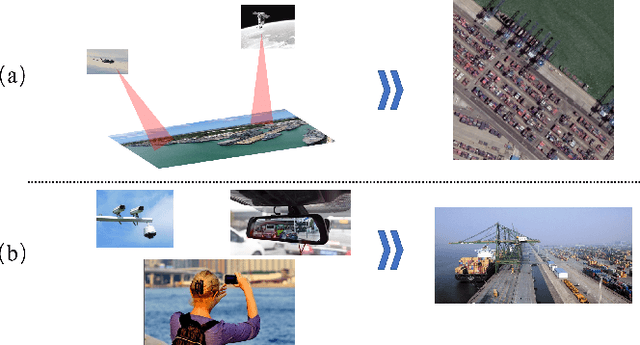
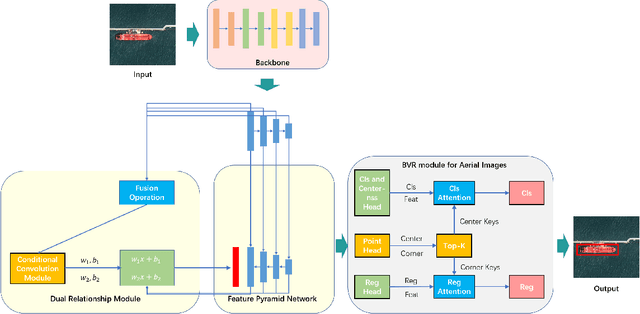
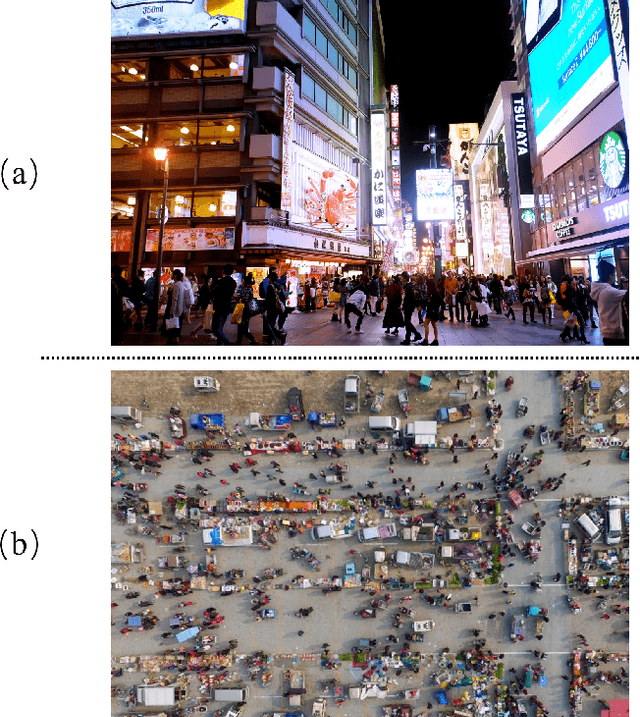
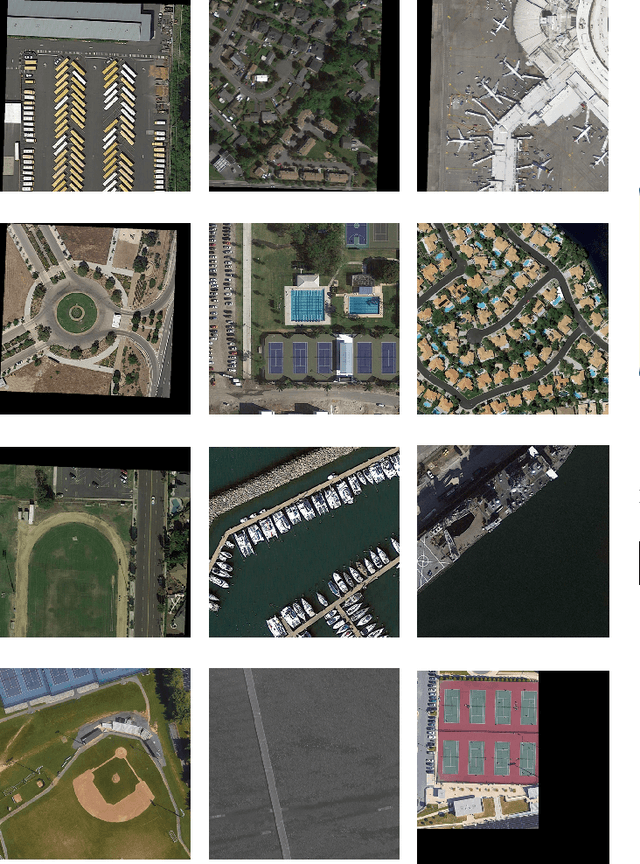
Abstract:Object detection is a basic and important task in the field of aerial image processing and has gained much attention in computer vision. However, previous aerial image object detection approaches have insufficient use of scene semantic information between different regions of large-scale aerial images. In addition, complex background and scale changes make it difficult to improve detection accuracy. To address these issues, we propose a relationship representation network for object detection in aerial images (RelationRS): 1) Firstly, multi-scale features are fused and enhanced by a dual relationship module (DRM) with conditional convolution. The dual relationship module learns the potential relationship between features of different scales and learns the relationship between different scenes from different patches in a same iteration. In addition, the dual relationship module dynamically generates parameters to guide the fusion of multi-scale features. 2) Secondly, The bridging visual representations module (BVR) is introduced into the field of aerial images to improve the object detection effect in images with complex backgrounds. Experiments with a publicly available object detection dataset for aerial images demonstrate that the proposed RelationRS achieves a state-of-the-art detection performance.
Printed Texts Tracking and Following for a Finger-Wearable Electro-Braille System Through Opto-electrotactile Feedback
Aug 06, 2021Abstract:This paper presents our recent development on a portable and refreshable text reading and sensory substitution system for the blind or visually impaired (BVI), called Finger-eye. The system mainly consists of an opto-text processing unit and a compact electro-tactile based display that can deliver text-related electrical signals to the fingertip skin through a wearable and Braille-dot patterned electrode array and thus delivers the electro-stimulation based Braille touch sensations to the fingertip. To achieve the goal of aiding BVI to read any text not written in Braille through this portable system, in this work, a Rapid Optical Character Recognition (R-OCR) method is firstly developed for real-time processing text information based on a Fisheye imaging device mounted at the finger-wearable electro-tactile display. This allows real-time translation of printed text to electro-Braille along with natural movement of user's fingertip as if reading any Braille display or book. More importantly, an electro-tactile neuro-stimulation feedback mechanism is proposed and incorporated with the R-OCR method, which facilitates a new opto-electrotactile feedback based text line tracking control approach that enables text line following by user fingertip during reading. Multiple experiments were designed and conducted to test the ability of blindfolded participants to read through and follow the text line based on the opto-electrotactile-feedback method. The experiments show that as the result of the opto-electrotactile-feedback, the users were able to maintain their fingertip within a $2mm$ distance of the text while scanning a text line. This research is a significant step to aid the BVI users with a portable means to translate and follow to read any printed text to Braille, whether in the digital realm or physically, on any surface.
Learning Safe Neural Network Controllers with Barrier Certificates
Sep 18, 2020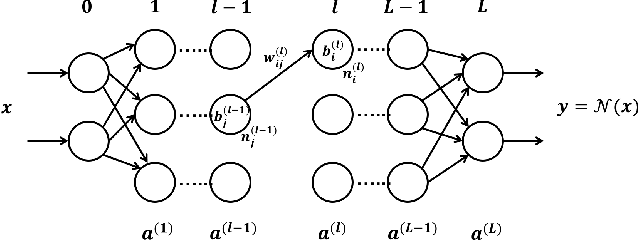

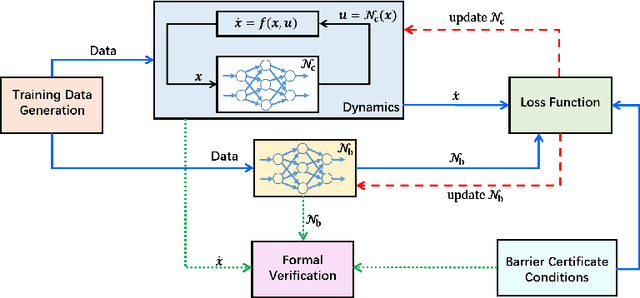

Abstract:We provide a novel approach to synthesize controllers for nonlinear continuous dynamical systems with control against safety properties. The controllers are based on neural networks (NNs). To certify the safety property we utilize barrier functions, which are represented by NNs as well. We train the controller-NN and barrier-NN simultaneously, achieving a verification-in-the-loop synthesis. We provide a prototype tool nncontroller with a number of case studies. The experiment results confirm the feasibility and efficacy of our approach.
Out-of-Distribution Detection with Distance Guarantee in Deep Generative Models
Feb 09, 2020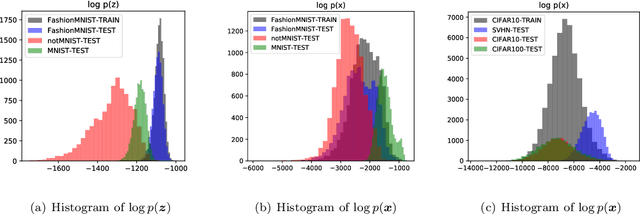
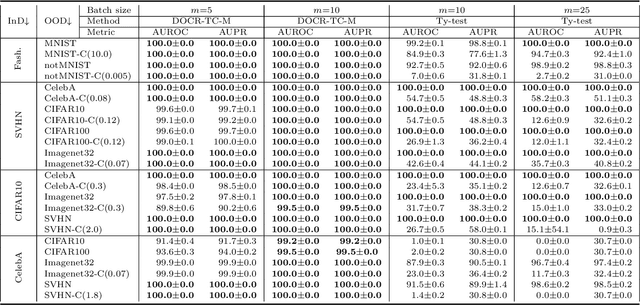
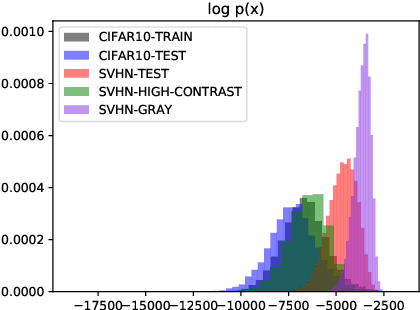

Abstract:Recent research has shown that it is challenging to detect out-of-distribution (OOD) data in deep generative models including flow-based models and variational autoencoders (VAEs). In this paper, we prove a theorem that, for a well-trained flow-based model, the distance between the distribution of representations of an OOD dataset and prior can be large enough, as long as the distance between the distributions of the training dataset and the OOD dataset is large enough. Furthermore, our observation shows that, for flow-based model and VAE with factorized prior, the representations of OOD datasets are more correlated than that of the training dataset. Based on our theorem and observation, we propose detecting OOD data according to the total correlation of representations in flow-based model and VAE. Experimental results show that our method can achieve nearly 100\% AUROC for all the widely used benchmarks and has robustness against data manipulation. While the state-of-the-art method performs not better than random guessing for challenging problems and can be fooled by data manipulation in almost all cases.
Deep Learning with Long Short-Term Memory for Time Series Prediction
Oct 24, 2018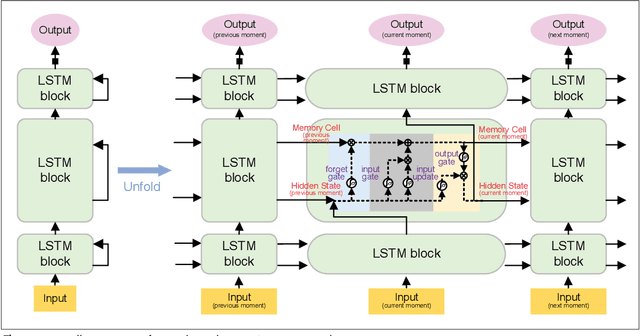
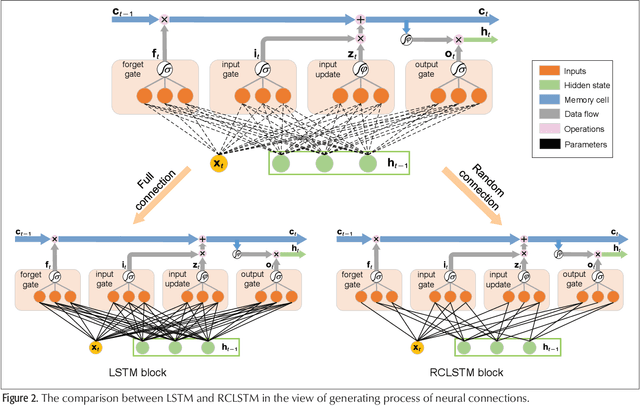
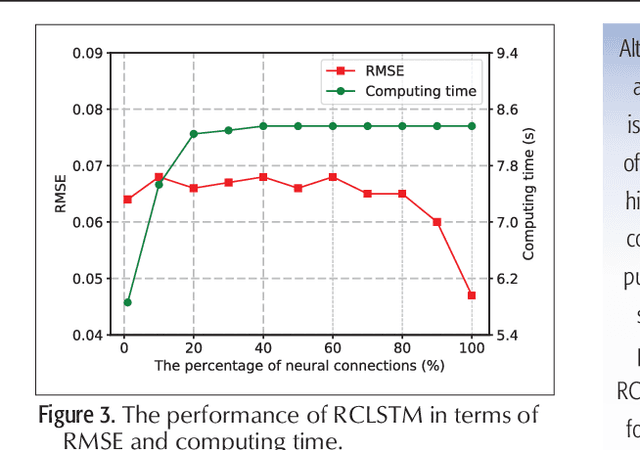
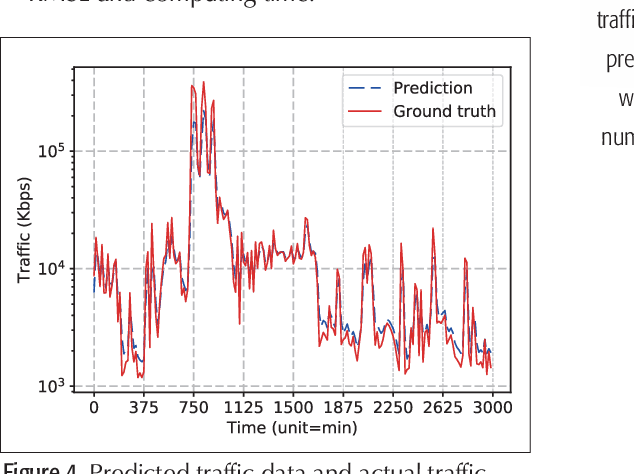
Abstract:Time series prediction can be generalized as a process that extracts useful information from historical records and then determines future values. Learning long-range dependencies that are embedded in time series is often an obstacle for most algorithms, whereas Long Short-Term Memory (LSTM) solutions, as a specific kind of scheme in deep learning, promise to effectively overcome the problem. In this article, we first give a brief introduction to the structure and forward propagation mechanism of the LSTM model. Then, aiming at reducing the considerable computing cost of LSTM, we put forward the Random Connectivity LSTM (RCLSTM) model and test it by predicting traffic and user mobility in telecommunication networks. Compared to LSTM, RCLSTM is formed via stochastic connectivity between neurons, which achieves a significant breakthrough in the architecture formation of neural networks. In this way, the RCLSTM model exhibits a certain level of sparsity, which leads to an appealing decrease in the computational complexity and makes the RCLSTM model become more applicable in latency-stringent application scenarios. In the field of telecommunication networks, the prediction of traffic series and mobility traces could directly benefit from this improvement as we further demonstrate that the prediction accuracy of RCLSTM is comparable to that of the conventional LSTM no matter how we change the number of training samples or the length of input sequences.
Traffic Prediction Based on Random Connectivity in Deep Learning with Long Short-Term Memory
Apr 03, 2018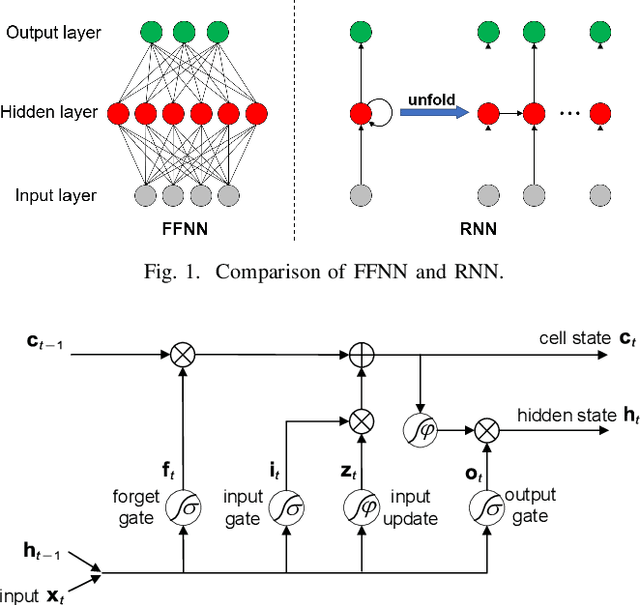
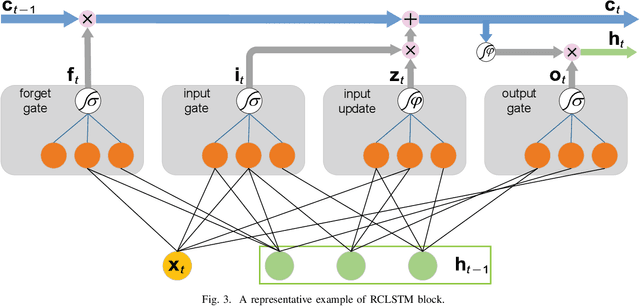
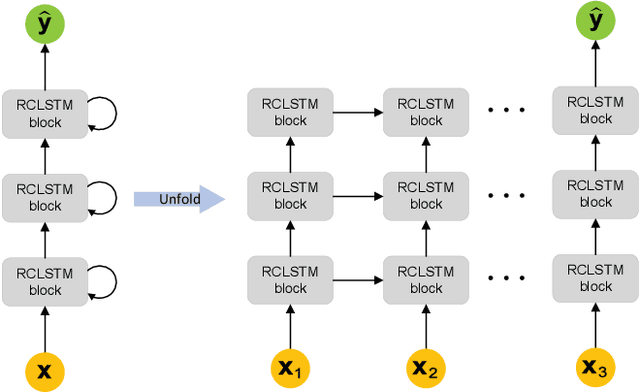
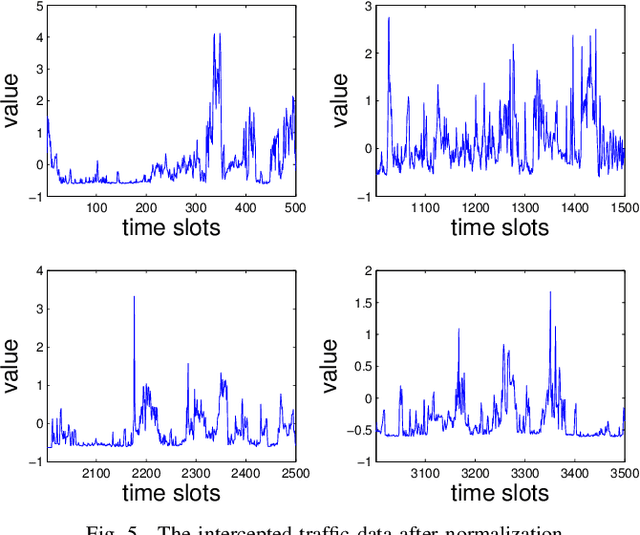
Abstract:Traffic prediction plays an important role in evaluating the performance of telecommunication networks and attracts intense research interests. A significant number of algorithms and models have been put forward to analyse traffic data and make prediction. In the recent big data era, deep learning has been exploited to mine the profound information hidden in the data. In particular, Long Short-Term Memory (LSTM), one kind of Recurrent Neural Network (RNN) schemes, has attracted a lot of attentions due to its capability of processing the long-range dependency embedded in the sequential traffic data. However, LSTM has considerable computational cost, which can not be tolerated in tasks with stringent latency requirement. In this paper, we propose a deep learning model based on LSTM, called Random Connectivity LSTM (RCLSTM). Compared to the conventional LSTM, RCLSTM makes a notable breakthrough in the formation of neural network, which is that the neurons are connected in a stochastic manner rather than full connected. So, the RCLSTM, with certain intrinsic sparsity, have many neural connections absent (distinguished from the full connectivity) and which leads to the reduction of the parameters to be trained and the computational cost. We apply the RCLSTM to predict traffic and validate that the RCLSTM with even 35% neural connectivity still shows a satisfactory performance. When we gradually add training samples, the performance of RCLSTM becomes increasingly closer to the baseline LSTM. Moreover, for the input traffic sequences of enough length, the RCLSTM exhibits even superior prediction accuracy than the baseline LSTM.
 Add to Chrome
Add to Chrome Add to Firefox
Add to Firefox Add to Edge
Add to Edge